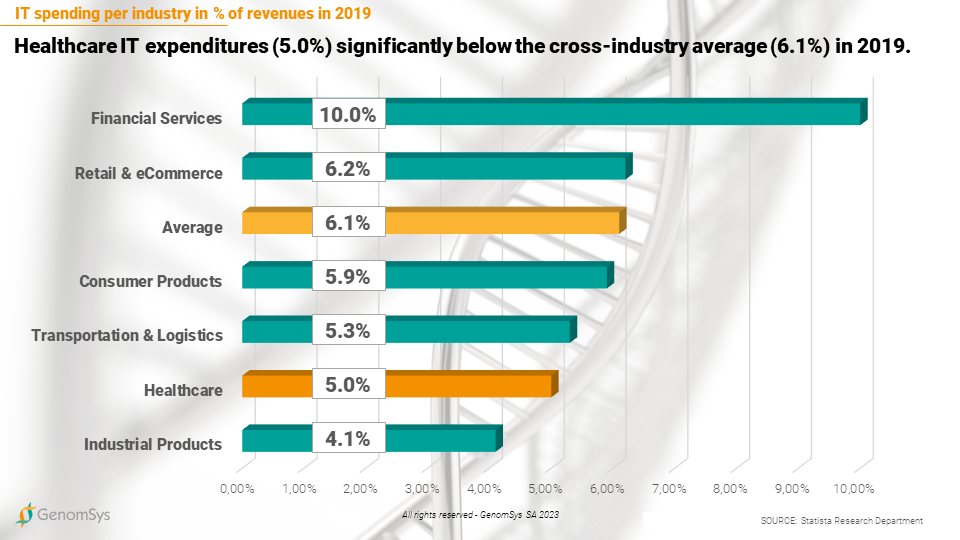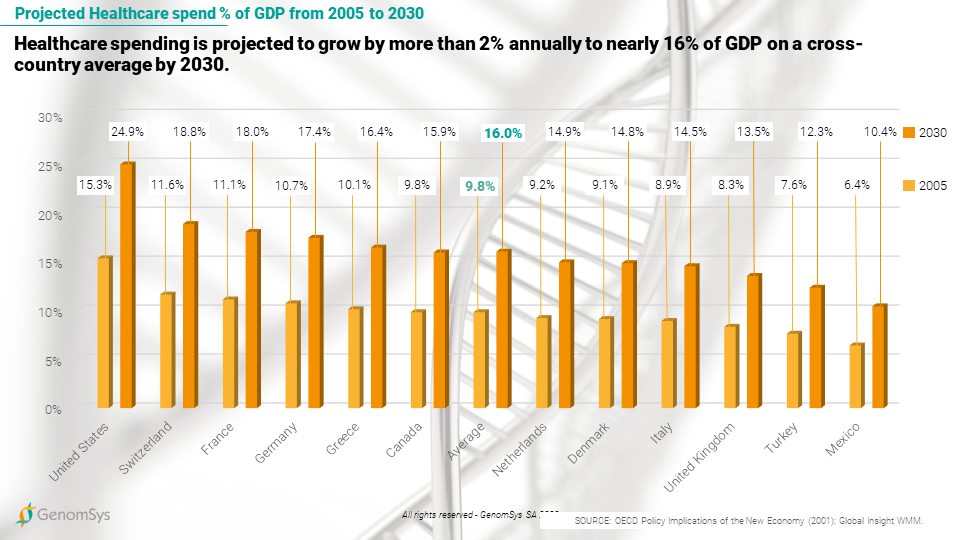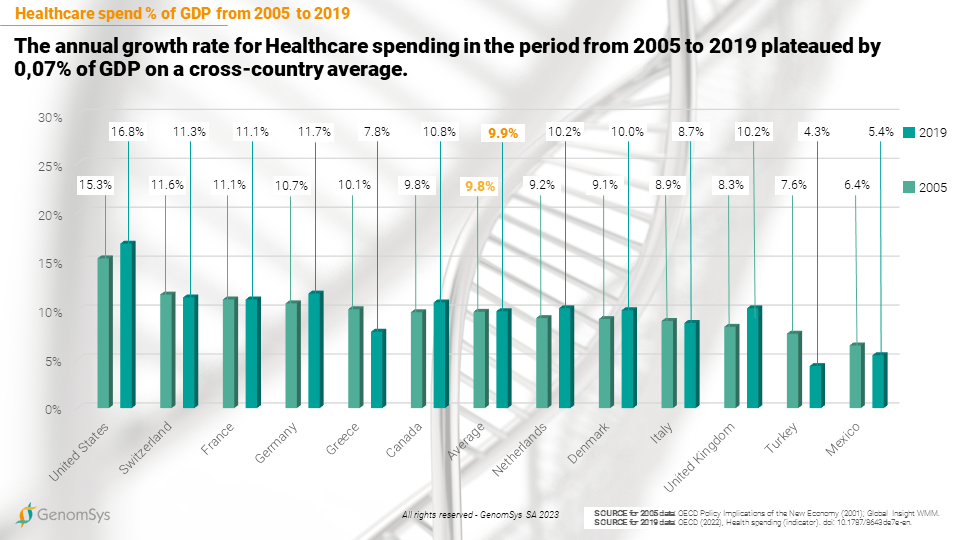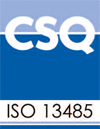Today is the last part of our series Healthcare in a mobile world – what is mHealth?. This time we want to go “back-to-the-future” by comparing the outlook report “mHealth: A new vision for healthcare” by GSMA and McKinsey & Company, with today’s reality for mHealth.
In case you missed our first two articles of the Healthcare in a mobile world – what is mHealth? series, you can find them here:
- mHealth – the 21st century’s mobility in Healthcare – Part 1
- mHealth – the 21st century’s mobility in Healthcare – Part 2
Statement A – IT-Spending – How did healthcare IT spending evolve in comparison to other industries?
Five years after the term mHealth was first introduced back, GSMA and McKinsey & Company published a report in 2010 highlighting the need for healthcare to innovate, pointing out that mHealth is a specific opportunity.[1]
mHealth, which evolved from eHealth, falls directly into the IT domain. For the report, the correlation between IT spending as a percentage of revenue amongst different industries is supposed to show the different adoption levels of IT as an innovation driver. The comparison included other industries such as financial services, telecommunications or insurance – to name a few – with that of the healthcare sector.[2]

Graphic 1 – IT spending per industry in % of revenues in 2005.[3]
The comparison showed that IT expenditures in the healthcare sector, spending 3.4% of its revenues on IT, was a little below the cross-industry average (3.5%) back in 2005. The industry leaders were financial services (5.8%) and telecommunications (5.1%), using technology intensively and investing significantly in IT development and IT-enabled innovations.[2]
The latest study on IT spending per industry from 2019 shows that the healthcare sector has spent 5% of its revenues on IT, which has almost doubled since 2005.[5] This is also supported by data from the Global Health Expenditure Database, which shows that, on average, healthcare spending has doubled in 187 countries since 2002.[6]
But still, IT spending in healthcare is expandable considering that it is now significantly below the cross-industry average in 2019. Healthcare should be open to leveraging the experience of other sectors that are already using technology to improve their processes. Industries, besides the previous frontrunner financial services (10%), like retail & eCommerce (6.2%) or transportation and logistics (5.3%), have surpassed the healthcare sector and can be seen as examples of how to innovate their delivery.[5]

Graphic 3 – IT spending per industry in % of revenues in 2019.5
As suggested back in the report of 2010, mHealth can make a vast difference by utilizing mobile communication technologies to deliver healthcare services and innovate its delivery model. Healthcare could learn from experiences of other industries – particularly retail & eCommerce – that have seen a high level of adoption by their customers for their new value proposition, using technological innovations like the smartphone.
Statement B – Healthcare costs – How did the healthcare expenditures develop? And what is the outlook today?
The delivery of effective, safe, and affordable healthcare to citizens comes at a price, and specific developments worldwide impact these costs. Lowering costs but still delivering steadily increasing quality of healthcare is vital for nations all across the globe.
The report projected to reach almost 16% of GDP for healthcare expenditure on average for a selected group of OECD countries (United States, Switzerland, France, Germany, Greece, Canada, Netherlands, Denmark, Italy, United Kingdom, Turkey, and Mexico) by 2030 with an annual growth rate of more than 2%. Switzerland (11.6%) and the United States (15.3%) were the frontrunners in 2005, followed by France (11.1%), Germany (10.7%), Italy (8.9%), and the United Kingdom (8.3%).[2]

Graphic 4 – Healthcare spending is projected to increase from a cross-country average of 9.8% of GDP (2005) to nearly 16% by 2030 with an annual estimated growth rate of 2%.[2]
In 2019 the same group of OECD countries spent on average 9,9% of their GDP on healthcare.[7] And therefore not reaching the previously estimated annual increase of 2%. The growth in healthcare costs had reached a plateau from 2005 to 2019.

Graphic 5 – Healthcare spending plateaued from a cross-country average of 9.8% of GDP (2005) to 9.9% by 2019 with an annual growth rate less than the estimation in 2005 with 0.07%.7[8]
However, the plateau from 2005 to 2019 is only a snapshot. The OECD still estimates that health expenditure will outpace GDP growth over the next ten years in almost every OECD country. The average health expenditure in reference to the GDP is expected to reach 10.7% by 2030 across the OECD countries. Although this is less than projected previously, the COVID19 pandemic is expected to drive expenditures up, which limited data today already suggests.[7]
Let alone the impact of aging populations, medical procedure costs, and resource restraints will drive up healthcare costs, thus increasing the need to drive innovation in this field to deliver effective, safe, and affordable healthcare to citizens.
In particular, patient empowerment is a rising indicator of where the journey may be headed, and this time it might be driven – not by governments – but citizens. That’s where mHealth comes into play. 85% of American adults have a smartphone and can download over 350,000 mHealth apps available in major app stores today, ranging from medical to health and fitness applications – each iPhone comes equipped with its health app by default.[9] This has generated an increasing number of positive user attitudes towards digital medicine and higher expectations regarding treatment delivered through their smartphone – hello, mHealth.
Statement C – Which suggested models of application for mHealth has developed so far? And did they improve efficiency and efficacity in healthcare?
As mentioned in our previous article on mHealth and its benefits, mHealth can support the administrative healthcare process, can be a convenient delivery model to raise awareness and be used during the monitoring and surveillance of patients.
In the forecast report co-authored by our CEO, five potential application areas were presented in which mHealth can cause a paradigm shift.
| From traditional
healthcare delivery … |
… to a new world paradigm | Area |
| Patient visits the physician or the ER, taking time off from work when he/she feels serious symptoms | Patient calls caregiver at his/her convenience any time of day/week as soon as symptoms begin. | Consultation |
| Chronic shortage of (specialized) medical talent | Patient can access global medical expertise in a connected world. | Consultation |
| Physician interviews patient in person and conducts a typical hands-on examination | Physician speaks to patient over phone, relying also on data from biometric sensors. | Examination |
| Physician prescribes medicine and hopes patient takes it at prescribed times | Digital reminders ensure that patient takes medicine as prescribed; can report side effects, etc. in real time. | Monitoring |
| Patient gets well and goes back to potentially unhealthy lifestyle | Patient can be monitored remotely and advised if conditions worsen or if lifestyle elements negatively impact the situation. | Prevention |
Graphic 6 – Mobile can fundamentally innovate healthcare delivery models in terms of consultations, examination, monitoring as well as prevention through education.[2]
In the following, we want to show which of these ideas have already been implemented and what impact they have already had.
Consultation – Scheduling appointments, video consultation and specialist doctors local availability
Scheduling a doctor’s appointment in the past included analog research (e.g., phonebooks) and was usually based on word-to-mouth recommendations to select a “good” and “reliable” physician – especially difficult when talking about the limited amount of specialists in a specific field -, calling the practice during office hours, taking time off of work to go to the appointment. The uncertainty of selecting an appropriate physician, having only a brief timeframe (office hours only) to schedule an appointment, and taking a vacation day to have the appointment, were some of the circumstances that were estimated to be eradicated by mHealth and make it easier for the patients.[2]
Nowadays, using smartphones and specific internet search engine applications for physicians and other healthcare professionals (e.g., Jameda) has become widely adopted. The hoped-for benefits are increased transparency on the service quality of the physician, convenience in scheduling appointments, and even time savings for doctor visits.
Video consultations can help provide patients in underserved rural areas with services, mainly when specialists are locally unavailable, saving time and costs for making longer trips to their practices. In addition, a three-way video consultation between the patient, a general practitioner, and a specialist or another service provider is also conceivable, including all the necessary stakeholders to improve efficiency and save precious time in the patient’s treatment process.[10]
Video consultation has experienced a substantial boost in the COVID19 pandemic – and could also establish itself in healthcare in the long term. For example, in Germany, according to a representative survey conducted by the IT industry association Bitkom for the study “Digital Health 2020” almost 50% of Germans, although they never before used a video consultation with their physician, expect to use it in the future. The participants involved in the study claimed, besides the fear of getting invected by COVID19 (85%), that convenience (>50%) is one of the reasons for this.[11]
Looking at the national development in Germany for offering video consultations, while in 2017, only 1.8% of the physicians provided video consultation as a service, nearly 52% did so in May 2020. This resulted from a recent survey of physicians as part of the study “Doctors in the Future Market of Health 2020”. The same study showed that patients are also increasingly interested in the possibilities of telemedicine. Downloads of relevant apps increased by up to 200% between January and April 2020; the top 5 telemedicine apps were downloaded more than 90,000 times, according to data from analytics tool AppTweak.[12]
Besides the convenience to book appointments at any time of the day, receive automatic reminders, and even hold the consultation digitally through a video conference – these apps provide patients information on the experiences of other patients with the corresponding physician. Most of the time, these ratings provide certain transparency to patients to select their healthcare provider.
So, today mHealth, in terms of video consultations and the administrative process, has already arrived and is becoming increasingly used due to the convenience factor.
Examination – Remote examination through smartphone and mHealth app
How can a physical examination be replaced through mHealth? What seemed impossible could be done through specific software and essential functions of smartphones, such as the camera that can record vital signs like blood pressure. However, it is important to mention that digital delivery should not wholly replace personal health care. Still, some examinations could benefit from the supplement of mHealth applications.[10]
A Canadian research group found evidence in 2018 that a mHealth app can outperform a traditional in-person exam measuring blood flow in a patient’s wrist. The mHealth app installed on an iPhone reached a diagnostic accuracy of 94% in measuring blood flow in the radial and ulnar arteries in the wrist of patients undergoing coronary angiography. Physicians, however, only reached an accuracy of 84% by doing a modified Allen test.[13]
Based on this finding, the widespread availability of smartphones can be used in the future for point-of-care diagnostics in hospitals with close to no costs. Specific mHealth applications could then use, for example, built-in cameras with specific sensors using infrared light-emitting diodes to render smartphones into functional plethysmographs.[14]
Although most of these applications are not yet certified today for clinical use by any regulatory body, experts foresee that the impact of digital technologies will be both disruptive and transformative in healthcare. Technologies such as artificial intelligence, virtual reality, and blockchain will further expand the possibilities for mHealth.[14]
But today, such mHealth applications are still not very common. Studies from the US Food and Drug Administration show that few mHealth technologies receive approval for clinical study and thus do not get implemented into the routine care process. A significant drawback is the uncertainty about the regulatory standards that apply to many mHealth applications.[14]
Monitoring – Unprecedented possibilities to see the full picture
The gained mobility through mHealth is an important asset when looking at monitoring specific actions or measuring vital signs using wearables. This mobility can help physicians interact with their patients on a new level with convenient automated messaging or receiving a complete picture of the health status over a long time.
Therapeutic adherence – the measure by which patients follow the doctor’s directions and recommendations (e.g., medication intake) – as suggested by a report of the World Health Organization (WHO) for long-term therapies was only at 50%.[15] Here is where mHealth could come in to support in raising the therapeutic adherence. Apps installed on the smartphone (e.g., MedMinder, MyTherapy Pill Reminder, TabTime Timer) already exist and add ease and simplicity to adhering to your medication intake.[16] These applications provide significant advantages like cost-effectiveness and simplicity to use to increase therapeutic adherence.[17]
The beforementioned wearables also open up new opportunities to improve health care through mHealth. Although the report from 2010 had not foreseen wearables as a valuable part of mHealth, mainly because the first fitness-tracking wristband entered the market in 2011, the trend of wearables (e.g., smartwatches) to increase the overall health has been growing since then.[18] These gadgets are designed to keep track of vital signs 24/7 and store it within mHealth applications on the smartphone. This level of surveillance has previously only been possible in specific laboratories. It is now cost-effective and applicable on a broader scale as most citizens in the Western world have at least a smartphone, and the number of wearables is increasing. Monitoring using mHealth is prone to become a key tool in maintaining health by diagnosing patients with inconsistent symptoms or delivering simple information such as blood pressure over a longer time than just one single measurement in the clinic.[19]
Prevention – educating and raising awareness through mHealth
Prevention starts when one knows what to avoid. This knowledge can only be generated through education and raising awareness. mHealth applications could be used as channels to provide convenient and direct information to individuals, even in rural areas, through their smartphones. An example is the “Raising health awareness in Bangladesh via SMS campaigns”.[20]
The Ministry of Health and Family Welfare of Bangladesh has taken advantage of the rapidly increasing number of mobile telephone subscribers in their country and started a project to raise awareness of its health campaigns by broadcasting SMS text messages to all mobile telephone numbers in the country. The messages range from encouraging parents to bring their children to get vaccinated to other large-scale nationwide health campaigns, such as its Vitamin A Week, National Breastfeeding Week, and National Safe Motherhood Day.[19]
Curated and validated information coming from mHealth applications that have passed the high standards for medical devices through notified bodies and thus guaranteeing safety for patients, implemented in healthcare can help raise the level of understanding of why and how specific diseases can be prevented. The convenience of mobility can be leveraged to deliver this healthcare service at low costs to anyone.
The estimated new world paradigm shift, is it already there?
Most of the estimated foreseen application fields that were mentioned in the report from 2010 are already confirmed today. The following shows a brief overview of this comparison:
| The estimated new world paradigm shift… | … is it already there? |
| Patient calls caregiver at his/her convenience any time of day/week as soon as symptoms begin | Yes, mHealth applications are already available for scheduling appointments online, video consultation, and increasing specialist doctors’ availability through digital channels. |
| Patient can access global medical expertise in a connected world | |
| Physician speaks to patient over phone, relying also on data from biometric sensors. | mHealth applications combined with smartphone functions exist and show promising results but are not yet ready for clinical use due to the missing framework in regulations. |
| Digital reminders ensure that patient takes medicine as prescribed; can report side effects, etc. in real time | Yes, multiple apps are available to ensure higher therapeutic adherence. |
| Patient can be monitored remotely and advised if conditions worsen or if lifestyle elements negatively impact the situation | For the last decade, smartphones, mHealth applications, and wearables have established a monitoring service to increase overall health – so yes, mHealth provided new ways for medical monitoring. |
Graphic 7 – Most of the suggested mHealth applications have already made its way to reality.
Conclusion – mHealth is still not fully implemented in healthcare but accelerators are on the horizon
In summary of this comparison between the outlook report “mHealth: A new vision for healthcare” with today’s reality for mHealth showed that some mHealth application have already been established and hint to a more efficient, cost-effective and more convenient future, but healthcare is still lacking to implement more of these new technologies into its routine process.
As shown the healthcare costs will rise further, most of the costs due to COVID19 will appear in the next couple of years, and hence is in desperate need to use innovative technologies to deal with the future challenges.
One particular mentioned development the patient empowerment will accelerate mHealth applications and leveraging synergies from other industries for example from retail & eCommerce can help healthcare to understand on how to implement innovative technologies which will be sooner or later demanded by patients.
Amazon is a prime example of how retail has changed. Thanks to the smartphone’s mobility, it is now possible for us to shop at any time and conveniently receive the goods – sometimes within the next hour – wherever we are. Besides the apparent convenience benefit, the example of Amazon delivers proof that a wide-scale approach is possible (worldwide delivery) and that the masses accepted, adopted, and want it.
What does GenomSys provide in terms of mHealth?
At GenomSys, we address these developments head-on. We rightfully want to establish actual personalized medicine through mHealth in genomics. Our solutions reflect the need for high-level data privacy, convenience, and high interoperability. All this is combined in our standard for genomic data (MPEG-G), which is at the core of all our solutions within the GenomSys MPEG-G Genomic Platform.
Our unique multi-infrastructure genomic platform compliant with ISO/IEC 23092 (MPEG-G), the only ISO open standard for genomic data, combines the professional world with the individual world in genomics. We aim to enable individuals to access and use their genomic information, providing science-based yet ethically-compliant insights, granting the highest level of privacy and security. Meeting the new trend by providing a solution where individuals demand a higher control and true ownership of their data.

Our GenomYou app is designed to bring the benefits of current mHealth applications to the genomic field. We want to bridge the need for a high level of data privacy – what is more private than our genetic information? – and convenience from our handheld devices. GenomYou allows ordering a DNA sequencing, storing your genomic data only on your phone and nowhere else, running analysis and receiving the results directly in your phone and getting in contact with genomic experts or your physician for further actions*.

Our support for professionals from our unique multi-infrastructure genomic platform is to extend genomic capabilities beyond physical footprint, offering an innovative yet digital genomic service granting secure data sharing with the ultimate level of privacy protection of sensitive individual genomic data. Always bearing in mind the high level of security while dealing with such sensitive data – our DNA – yet providing forward-looking solutions to meet the increased requirements to share data and still remain cost-efficient, especially in terms of a high volume of data that needs to be stored.
One of our professional solutions is GenomSys Variant Analyzer, a CE-marked platform supporting professionals in the secondary and tertiary analysis and interpretation (SNVs, indels, CNVs) of genome sequencing data. Natively operating on the new international genomic standard (MPEG-G), GenomSys Variant Analyzer accelerates the delivery of precision medicine.
We believe that healthcare in the future will be an ecosystem consisting of state-of-the-art tools for professionals and convenient, highly secure applications for citizens to take action when it comes to their health easily.
By Lucas Laner on May 30th, 2023.
References:
[1] Robert S. H. Istepanian, Costantinos S. Pattichis, Swamy Laxmiinarayan; Ubiquitous mHealth systems and the convergence towards 4G mobile technologies. In: mHealth. Emerging Mobile Health Systems. (2006)
[2] Parker Moss, Alessio Ascari, Ajay Bakshi, Ferry Grijpink; mHealth: A new vision for healthcare (2010). https://www.gsma.com/iot/wp-content/uploads/2012/03/gsmamckinseymhealthreport.pdf
[3] Statista Research Department; Information technology (IT) worldwide spending from 2005 to 2023 (2022).
[5] Statista Research Department; IT spending as share of company revenue in 2019, by industry (2019).
[6] World Health Organization; Global Health Expenditure Database (2022). Data Explorer.
[7] OECD; Health spending set to outpace GDP growth to 2030 (2019). https://www.oecd.org/health/health-spending-set-to-outpace-gdp-growth-to-2030.htm
[8] OECD (2022), Health spending (indicator). doi: 10.1787/8643de7e-en
[9] Remy Franklin; 11 surprising mobile health statistics (2021). https://mobius.md/2021/10/25/11-mobile-health-statistics/#:~:text=There%20are%20over%20350%2C000%20mHealth,as%20health%20and%20fitness%20apps.
[10] Timo Thranberend, Dr. Florian Hartge, Christian Fink; Video Consultations. An effective tool for outpatient care – Acceptance among doctors is key to leveraging usage (2015). https://www.bertelsmann-stiftung.de/fileadmin/files/BSt/Publikationen/GrauePublikationen/SpotGes_VideoConsultations_en_final_web.pdf
[11] Jürgen Klöckner; Telemedizin: Jeder zweite Nutzer zieht Videosprechstunde dem Arztbesuch vor (2020). https://www.handelsblatt.com/technik/medizin/bitkom-studie-digital-health-2020-telemedizin-jeder-zweite-nutzer-zieht-videosprechstunde-dem-arztbesuch-vor/25986384.html?ticket=ST-14762347-6AWrBtRrptw5WcDBnFkO-ap6
[12] McKinsey & Company; eHealth Monitor 2020 (2020). https://www.mckinsey.de/~/media/mckinsey/locations/europe%20and%20middle%20east/deutschland/news/presse/2020/2020-11-12%20ehealth%20monitor/ehealth%20monitor%202020.pdf
[13] Pietro Di Santo, David T. Harnett, Trevor Simard, F. Daniel Ramirez, Ali Pourdjabbar, Altayyeb Yousef, Robert Moreland, Jordan Bernick, George Wells, Alexander Dick, Michel Le May, Marino Labinaz, Derek So, Pouya Motazedian, Richard G. Jung, Jaya Chandrasekhar, Roxana Mehran, Aun-Yeong Chong and Benjamin Hibbert
CMAJ April 03, 2018 190 (13) E380-E388; DOI: https://doi.org/10.1503/cmaj.170432
[14] Eric Wicklund; An mHealth App Beats The Physical Exam For Accuracy in One Study (2018). https://mhealthintelligence.com/news/an-mhealth-app-beats-the-physical-exam-for-accuracy-in-one-study
[15] World Health Organization (WHO); Adherence to long-term care. Evidence for Action (2003).
[16] Brian Krans; 6 of the Best Reminders for Your Medications (2020). https://www.healthline.com/health/best-medication-reminders
[17] Orcioni, S.; Pellegrini, R.; Seepold, R.; Gaiduk, M.; Madrid, N.M.; Conti, M. Medication adherence supported by mHealth and NFC. Inform. Med. Unlocked 2021, 23, 100552.
[18] Cornelia Kelber, Pia Nagel; Wearables: Auf dem Weg zur Menschmaschine (2016). https://www.zukunftsinstitut.de/artikel/wearables-auf-dem-weg-zur-menschmaschine/
[19] Dileep Gupta; Wearables – The Emerging Future Trend for the mHealth Apps (2021). https://appinventiv.com/blog/wearable-technology-in-healthcare/
[20] S. Michael Ross; What Are the Benefits of Mobile Health Technology? (2019); https://blog.cureatr.com/benefits-of-mobile-health-technology




